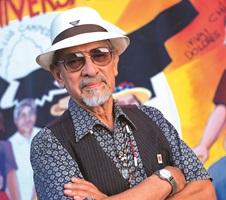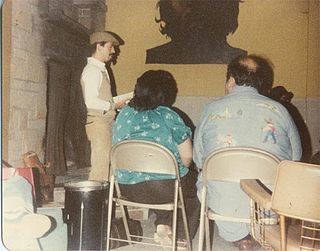
José Montoya was a poet and an artist from Sacramento, California. He was one of the most influential Chicano bilingual poets. He has published many well-known poems in anthologies and magazines, and served as Sacramento's poet laureate.

Alberto Baltazar Urista Heredia, better known by his nom de plume Alurista, is an American poet and activist. His work was influential in the Chicano Movement and is important to the field of Chicano poetry.

Chicano poetry is a subgenre of Chicano literature that stems from the cultural consciousness developed in the Chicano Movement. Chicano poetry has its roots in the reclamation of Chicana/o as an identity of empowerment rather than denigration. As a literary field, Chicano poetry emerged in the 1960s and formed its own independent literary current and voice.
Kathy Vargas is an American artist who creates photographs from multiple exposures that she hand colors. She often devotes several works to a particular theme, creating series.
César Augusto Martínez is an artist, prominent in the field of Chicano art. While studying at what was then called Texas A&I College, he became involved in the Chicano movement for civil rights. He subsequently befriended several of its leaders.

The Mexican American Youth Organization is a civil rights organization formed in 1967 in San Antonio, Texas, USA to fight for Mexican-American rights. The creators of MAYO, Los Cinco, consisted of José Ángel Gutiérrez, Willie Velásquez, Mario Compean, Ignacio Pérez, and Juan Patlán. MAYO and its political organization, Raza Unida Party, played an important part in Texas history during the late 1960s and early 1970s. They were a part of the larger Chicano movement in the United States, and played a role in bringing about civil rights for Mexican-Americans.
Ricardo Romo is an American urban historian who served as the fifth President of the University of Texas at San Antonio from May 1999 to March 2017.

Jason Villegas is a San Francisco based contemporary artist. He has exhibited across the United States and internationally. Villegas' work includes sculpture, installation, painting, drawing, textile, video and performance, exploring concepts such as globalism, evolution, sexuality, cosmology, and consumerism. Motifs in Villegas' artworks include fashion logos, animal hybrids, weaponry, sales banners, clothing piles, anuses, cosmic debris, taxidermy, bear men, amorphous beasts, religious iconography, and party scenarios.
Luis Gutierrez is an American artist based in Los Gatos, California, USA.
José Arpa y Perea (1858–1952), was an artist of Spanish birth who worked in Spain, Mexico, and Texas and was noted for his Costumbrista studies and his landscapes of Texas.

The Chicano Art Movement represents groundbreaking movements by Mexican-American artists to establish a unique artistic identity in the United States. Much of the art and the artists creating Chicano Art were heavily influenced by Chicano Movement which began in the 1960s.
Santa Barraza is an American mixed-media artist and painter who is well known for her colorful, retablo style painting. A Chicana, Barraza pulls inspiration from her own mestiza ancestry and from pre-Columbian art. Barraza is considered to be an important artist in the Chicano art movement. The first scholarly treatment of a Chicana artist is about her and is called Santa Barraza, Artist of the Borderlands, which describes her life and body of work. Barraza's work is collected by the Mexic-Arte Museum, and other museums around the United States and internationally. She currently lives in Kingsville, Texas.
Melesio "Mel" Casas was an American artist, activist, writer and teacher. He is best known for a cycle of complex, large-scale paintings characterized by cutting wit, incisive cultural and political analysis, and verbal and visual puns that he called Humanscapes, which were painted between 1965 and 1989. Only a few of these Humanscapes address Chicano topics, though they are his most famous paintings, and "have appeared repeatedly in books and exhibitions" and "are rightfully regarded as formative icons of the Chicano art movement." Many of the Humanscape paintings, by contrast, are little known, as is much of the work Casas produced in the following quarter century.

Carmen Tafolla is an internationally acclaimed Chicana writer from San Antonio, Texas, and a professor emerita of bicultural bilingual studies at the University of Texas at San Antonio. Tafolla served as the poet laureate of San Antonio from 2012 to 2014, and was named the Poet Laureate of Texas for 2015–16. Tafolla has written more than thirty books, and won multiple literary awards. She is one of the most highly anthologized Chicana authors in the United States, with her work appearing in more than 300 anthologies.
Virginia Grise is a playwright, and director. Grise's most recognized work is blu, the winner of the 2010 Yale Drama Series Award and a finalist for the Kennedy Center for the Performing Arts' Latino/a Playwrighting Award. In addition, Grise is the co-writer of The Panza Monologues with Irma Mayorga, and edited a volume of Zapatista communiqués called Conversations with Don Durito. She is also a recipient of the Whiting Writers' Award and the Princess Grace Award in Theater Directing.
Margarita Cabrera is a Mexican-American artist and activist. As an artist, the objects and activities she produces address issues related to border relations, labor practices and immigration. Her practice spans smaller textile-based soft sculptures to large community-involved public artworks. In 2012 she was a recipient of the Knight Artist in Residence at the McColl Center for Visual Art in Charlotte, North Carolina. Cabrera was also a recipient of the Joan Mitchell Foundation Grant.
Margaret Herrera Chávez (1912–1992) was an American painter and printmaker.
Gaspar Enriquez is an American artist known for creating photorealist portraits, primarily of people of Chicano heritage. He uses the airbrush technique in his paintings. Enriquez is also a sculptor and a jewelry maker who works in metal.
José Esquivel, a Chicano artist and commercial artist based in San Antonio, Texas, has been called "one of the earliest and most important Chicano artists in Texas." He is best known for his depictions of life in Chicano barrios. Esquivel also spent a lengthy period as a wildlife artist between 1973 and 1991, when he withdrew from Chicano art due to its association with radicalism. As a commercial artist, Esquivel worked primarily for City Public Service, San Antonio’s public utility company. By the time he retired in 1987, he was the supervisor of the art department. His best and most influential work was connected to the Chicano Movement, and it is included in a number of prominent collections. Esquivel was also a co-founder of the San Antonio-based Con Safo art group, which was one of the earliest and most important Chicano art groups in the country.
Roberto Gonzalez is a Chicano artist, curator, and musician. He was a member of the San Antonio-based Con Safo art group in the mid-1970s. As an artist, he has exhibited locally, nationally, and internationally. Gonzalez worked primarily as an abstract artist from the 1970s until the early 2000s, after which time he emphasized pre-Columbian imagery in an effort to engage with his ancestors. He has also worked as a performance artist since 1974. Gonzalez has curated numerous exhibitions, notably at the Carver Cultural Center in San Antonio, where he served as the Fine Arts Administrator (1984-1995). Gonzalez is also a percussion musician who specializes in Pre-Hispanic and African Diaspora music. He has trained with several African Diaspora music masters and has been active in several musical groups.







